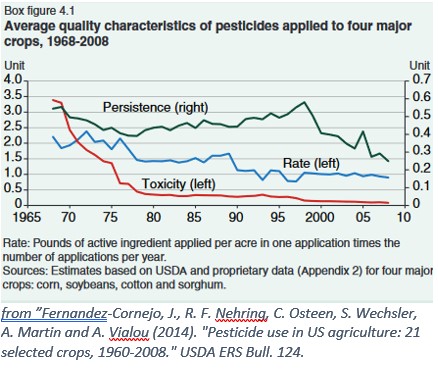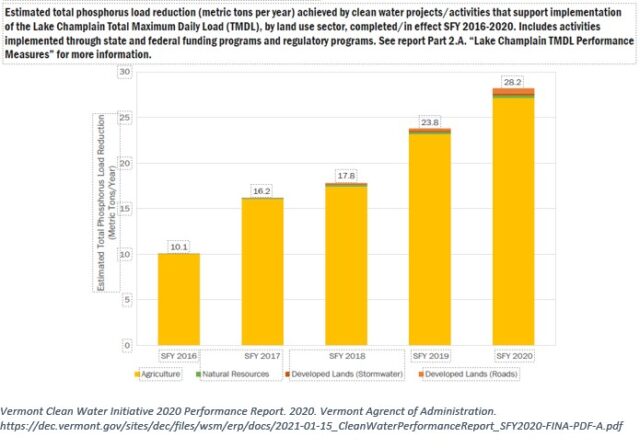Another year, another story on the egregious use of pesticides by Vermont farmers. A recent VPR story by John Dillon, titled “As Farmers Plant Cover Crops To Reduce Runoff, Report Says They Also Use More Herbicides”, is making the rounds in agriculture and food circles, raising eyebrows and calling for new rules against pesticide use. Unfortunately, the article and the report it draws upon are a gish-gallop of syllogism, innuendo, and poor data interpretation.
The article draws its story primarily from a ‘report’ by retired state chemist Nat Shambaugh, who spent his career measuring and analyzing residues in soils and waterways for the Vermont Agency of Agriculture, Food, and Markets (VAAFM). I have seen Nat’s presentations, as I served as chair of the Vermont Pollinator Protection Committee in 2016-2017. He tells a compelling story, and from the article, I thought he’d pulled his slide deck into a summarized report culled from publicly-available data informed by his years on the job. Unfortunately, we have to click two links out of the article, one rather deep into the website of the Lake Champlain Basin Program Citizen Advisory Council to find that this was not a peer-reviewed, written report. Rather the main source for this somewhat inflammatory story was another evening slide show at a public meeting with only spoken analysis that was reported by Dillon, who does not have expertise in pesticide policy. Such a stack of evidence makes for a weak policy argument.
Let’s get this out of the way first- Vermont farmers use pesticides, and cornfields are a major application site. That’s not in question here. I have seen a shift in the past 25 years that I have been in this field toward reduced pesticide inputs and reduced toxicity of those inputs overall. In field crops, those can be linked to three main factors: the regulatory ‘sticks’ that were the Food Quality Protection Act of 1995, which curtailed the use of many of the riskiest pesticides used in agriculture and the adoption of required Best Management Practices in Vermont in 2016, and the ‘carrot’ of conservation agriculture, which includes cover cropping and no-till planting and has led to marked improvements in soil health and reduced nutrient and soil runoff into waterways in Vermont.

As farming has changed, pesticide use has been reduced overall, and the toxicity of those materials used has dropped precipitously. A report from the USDA Economic Research Service reviewed pesticide use from 1960-2008 on 21 major crops in the U.S., and found a decrease in use rate, toxicity, and persistence of pesticides overall starting in the 1970s, and continuing into the modern, Conservation Agriculture period. While Shambaugh criticizes farmers and VAAFM for not aiming to reduce pesticide use as a general policy, one could argue that modern farming methods have done just that, and we have found a balance of the minimum it takes to produce crops on the scale adopted, and generally required, by farmers to be successful in today’s economy. Calls for increased use of Integrated Pest Management (IPM) on farms do not reflect that IPM already is the standard for most commercial crops in the region and has been for decades. Farmers and service providers like private crop consultants and Extension staff and faculty have worked together to develop and implement systems that balance biology, economics, and, yes, chemistry, to develop a sustainable farming system.
Because there is a general aversion to chemicals that is easily consumed by the reading public, it is easy to spin a tale by loading scary statistics into an article without context, as was done in this case. Much of Shambaugh’s report was derived from publicly-available pesticide application data from VAAFM. As mentioned in the article, pesticide use is self-reported by applicators in Vermont, but an important component was not mentioned: only commercial and government applicators are required to submit those records into the state’s database. Private applicators are required to track every use and must maintain records on file, but those data are not represented in use statistics. We can debate the merits of tracking such uses separately, but a critical and missing point in the presentation of this data that shows increasing pesticide use on a decreasing acreage of corn misses an important trend. As field sizes, and thus equipment investment, have increased, and the use of cover crops has made application timing more critical, many farms now contract their spraying out to the commercial applicators whose data are recorded in the state records. This means that farmers (private applicators) who used to apply pesticides but did not need to report are hiring custom (commercial) applicators who have to report every application. Without knowledge of the scope of that increase in reporting, we could blindly argue that the data are capturing more of possibly declining pesticide use in the state, just as much as Shambaugh argues that the data shows an increase in actual use.
The article also plays the common Roundup card, as glyphosate, the active ingredient in that popular pesticide, has shown the greatest increase in the past twenty years, irrespective of how the data were collected. Unlike many reports from recent years that point to the potential carcinogenicity of glyphosate, Dillon only points to the settlements in class action lawsuits against Bayer, maker of the Roundup brand. Multiple, scientific reviews for decades have consistently disputed the carcinogenicity claim, and every regulatory agency in the world has agreed with that assessment. The sole advisory body whose assessment the entire cancer case against glyphosate is built upon is an outlier among hundreds of reviews, and its determination of glyphosate as a likely carcinogen is highly suspect. Because the safety of glyphosate could not be successfully argued in the regulatory arena, that sole report serves as the basis for the class action cases staffed by late-night TV lawyers who see a potential cash windfall through abuse of tort law. Dillon’s article also cites a citizen report that highlights numerous other ecological and human harms of glyphosate, but ignores the contradictory findings from experts and regulatory agencies that weeded through the evidence presented therein and found much of it to be shoddy or of limited statistical or biological relevance. We could carry on discussing glyphosate for days, but thankfully, Dillon and Shambaugh moved on to other concerns. The fact remains that glyphosate and other herbicides are critical tools in the implementation of conservation agriculture at any meaningful scale, and that soil health has immensely improved as a result of its increased adoption.
Other pesticides, including atrazine and neonicotinoid insecticides, are referenced in the article, and in further detail in Shambaugh’s slide deck. We can agree that many of the compounds measured and reported in his data are of concern. However, there is no attempt made to report the scale or frequency of the high runoff events he cites. The data are cherry-picked, and present an illusion of a chemical wasteland surrounding agricultural fields. I don’t disagree that treatments prior to rainfall events or misapplications result in inacceptable runoff- it was the very data presented in his testimony to the pollinator committee that changed my mind to the idea that we need a better way to implement (or not, as may be the case) neonicotinoid seed treatments on crop seed. However, his presentation of this data would be strengthened by a complete analysis so that we may understand if the alarming instances he cites are commonplace or rare events. That his ‘gotcha’ slide showing dangerous levels of neonicotinoid runoff in single point collections on a single date in 2016 was the same one he showed us four years ago in his committee testimony suggests to me that he hasn’t made even a good faith attempt in the meantime at analyzing the data to show actual mean levels of pesticide runoff from Vermont farm fields.
There are multiple ways to maintain and improve soil health and water quality, and Vermont’s farmers across all ideological spectrums and management systems are doing just that. The 2020 report from the Vermont Clean Water Initiative indicates just how far the agriculture community has come in addressing pollution to Lake Champlain from all sources. For example, 38% of phosphorus pollution in the watershed is attributed to agricultural sources. While not a majority cause of P pollution, the agricultural sector is responsible for over 95% of the reduction in P loading into the watershed in recent years. That huge reduction in pollution from adoption of Conservation Agriculture is attained at a far lower cost than other mechanisms, such as stormwater treatment or retrofitting wastewater treatment plants. Farmers are using herbicides and other tools to achieve huge improvements in environmental quality throughout Vermont, and that is not to be discounted. A 2018 report from the Union of Concerned Scientists ranks Vermont first in the nation for adoption of conservation practices, and Vermont farmers also lead the nation in the amount of cover cropped farm acreage. These practices are paying off: the NRCS Rapid Carbon Assessment indicates that Vermont farms are sequestering carbon at an incredible rate, indicated by 5.6% soil organic matter in Vermont samples compared to 3.2% nationally (a 75% increase!). Clearly, we need to balance measurable improvements in soil health and water quality against speculative and specious claims of pesticide pollution.

Dialogue on agricultural pesticides is difficult. On the one hand, they are critical tools to ensure farm profitability, food safety, and a consistent and resilient food supply. They are also burdened with the baggage of unregulated development and use more than fifty years ago before the advent or modern and effective regulation that included some truly nasty materials and rampant, negligent use. However, it is critical that we have this discussion with an agreed-upon slate of facts and valid data from which farmers, consumers, and environmentalists can have reasonable discussion. Clearly more data, and improved analysis of the data that we presently have, is needed to make sound decisions that protect consumers and the environment while promoting our agricultural economy. Dillon’s article, unfortunately, doesn’t offer that nuanced and robust information.
Terence Bradshaw. February 17, 2021.
with Heather Darby and Kirsten Workman
UVM Extension